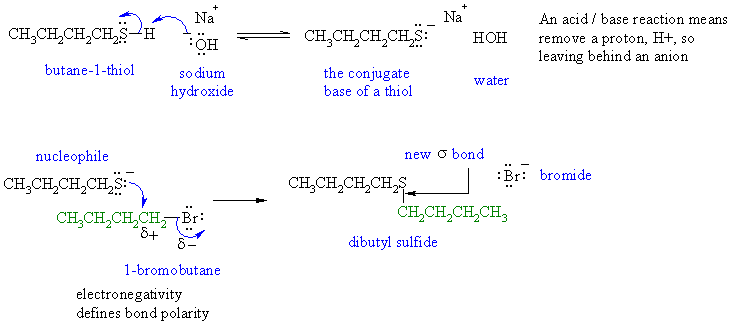
The following diagram shows the solution to the
mechanistic question. Note that all the information applies to a single
reaction sequence that has been completely described verbally.
There is no need for extra reagents or
extra steps etc. The curly arrows are drawn specifically to match the
text in the question. The biggest problem students have is making sure they
understand the language of chemistry. Most students have trouble because they
can't draw the structures from the IUPAC names (that means they don't know their
nomenclature well enough). Read the words carefully, and then make the curly
arrows tell that same story. There is NO need for extra steps. Remember
curly arrows go from electron rich to poor and to balance the
formal charges at each step - errors on formal charges were common.
a.

If you struggled with this part of the question, first draw the compounds whose names were provided, then think about the types of reactions (e.g. acid / base) and try to fill in the structures in the gaps, then finally add the required curly arrows to account for all the bonding changes.
b. The thiol pKa is about 10 and the pKa for water to hydroxide is about 16 so we should use bases that can deprotonate the thiol. This means selecting the conjugate base of an acid whose pKa is greater than 10.
Alkoxides, RO- (since ROH pKa is about 16) so any
alkoxide is possible.
The amide ion, -NH2 (since ammonia pKa = 35) is fine.
Carbanions such as CH3- are certainly strong enough.
c. Draw the structures and compare to the scheme.....need a thiol and a haloalkane to make the reaction work :

d. Why is hydroxide a poor choice ? The alcohol / alkoxide and the water / hydroxide equilibria have very similar pKas. Therefore the reaction of the alcohol with the hydroxide will not go to completion, it will go to about 50%. This means that there are two possible nucleophiles now if the reaction, the alkoxide, RO- and the hydroxide, HO-. The reaction of these two nucleophiles with the bromobutane will compete to give two different products and lower the yield of the desired ether product.
e. A thiol
is more acidic than an alcohol. Note that S and O are in the same group of the
periodic table. The thiol is more acidic because the sulfur atom is larger than
the oxygen atom. This has two effects. (1) it makes the S-H bond longer and
weaker than the O-H bond and so favours loss of H+. (2) it means that the conjugate
base of the thiol is more stable than that of the alcohol because the negative
charge is spread out over a larger surface area so lowering the charge density
in the thiolate (S-) compared to the alkoxide (O-).
f. Nucleophilic substitution. (link to list of possible types)
Common stumbling blocks for some students were :
b. Common errors included saying ammonia, NH3 or ammonium, NH4+. The pKa that applies for ammonia to function as a base is about 10. That makes it too weak. Water as a base (pKa = -2) and chloride (pKa = -7) are also far too weak as bases. Need a acid / base pKa above 16.
d. Common errors : saying there is no reaction of the hydroxide and the alcohol, saying that both are OH systems and therefore no reaction is not a complete enough answer. The ether does not react with the base, it's the alcohol that does (look at the scheme!) Saying that the proton will be both attached to O isn't really significant, nor is talking about the electronegativity of O.... think about reactions of hydroxide with (1) ethanoic acid (2) sulfuric acid and (3) HF or a thiol RSH. Hydroxide easily deprotonates (1) and (2) where the proton in the acid is attached to O. In (3), hydroxide will deprotonate both HF and RSH but F is more electronegative and S is less electronegative than O... so electronegativity isn't always a good indicator.
e.
Common errors : partial explanations that didn't hit the "why".
Note that saying it's more acidic because it has a lower pKa is not a "why"
- that is like saying it's hot in your house because the temperature is higher
: instead say it's hot in your house because you left the heat on or it's
south facing and you get lots of sun.
Lots of people confused atoms and molecules.... sulfur is a larger atom than
oxygen NOT a larger molecule.
If students said the alcohol was more acidic, then they usually talked about
electronegativity. S is below O in the periodic table so its less electronegative
than O. You should not compare the electronegativity of atoms in different
rows of the periodic table... it usually gives the wrong answer.